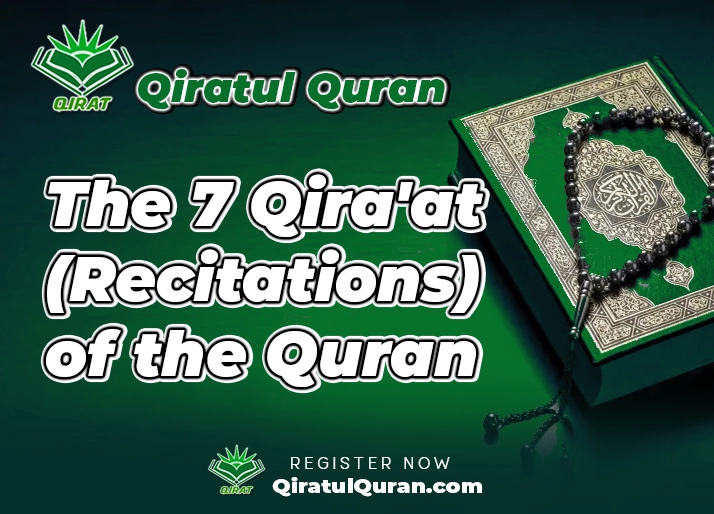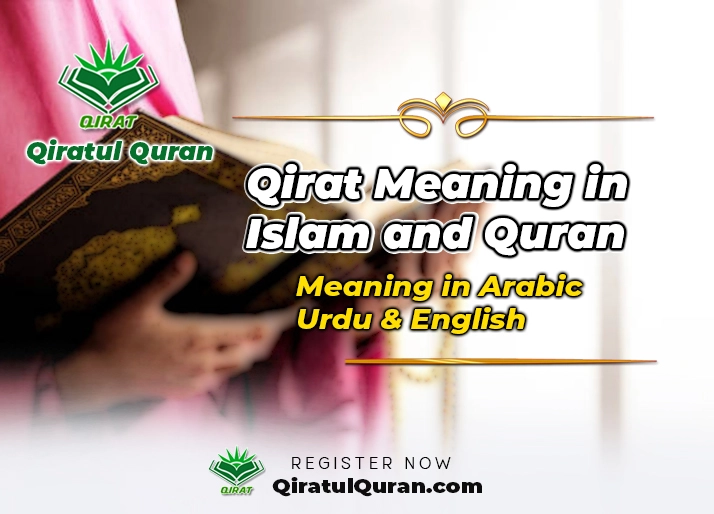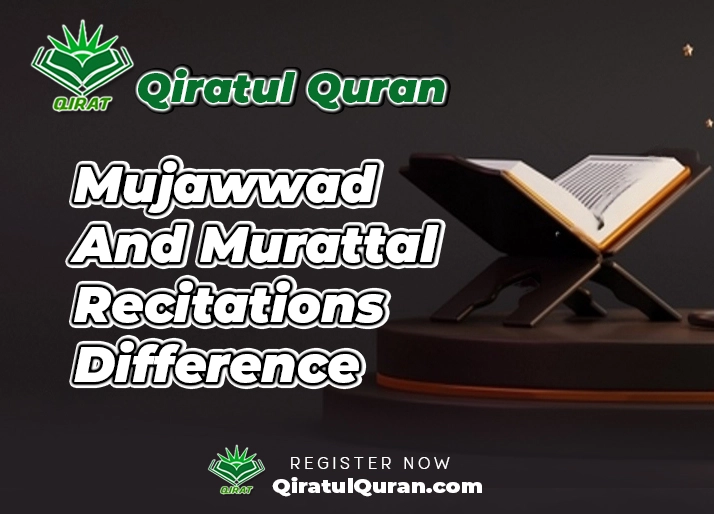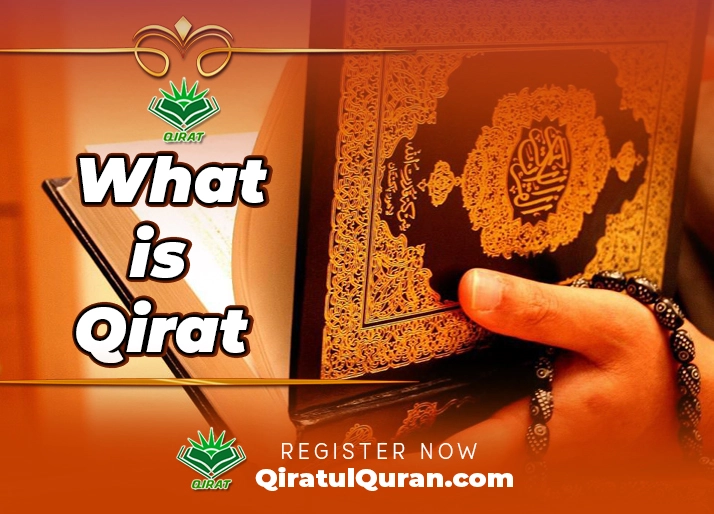The 7 Qira’at (Recitations) of the Quran: The Quran was revealed to Prophet Muhammad (peace be upon him) through the angel Jibreel (Gabriel) in the Arabic language. However, the text of the Quran has been preserved letter for letter, word for word, dot for dot as it was revealed, but more than one valid way of reciting the Quran has been established. These methods of recitation are called qira’at. There are 7 well-known qira’at that are considered authentic:

The Origin of the 7 Qira’at
The existence of variant recitations can be traced back directly to the Prophet (S.A.W) himself. Prophet Muhammad S.A.W would visit angel Jibreel every year in the month of Ramadan, where Jibreel would recite the entire Quran to him. In the last year of the Prophet’s life, Jibreel recited the Quran to him twice. Some variations that existed could be attributed to this continued recital over the years.
The Prophet also recited aloud in front of crowds of people in Mecca and Medina. His companions would memorize and write down the verses. However, Arabic being a rich language, variations in pronunciation and dialects exist. Some differences could be traced back to the Prophet’s recital itself.
After the Prophet’s death, the community decided to have a standardized copy of the Quran to prevent discrepancies from creeping into the text. A team was appointed under the leadership of Zayd ibn Thabit, one of the foremost scribes who had written down Quranic verses under the direct guidance of the Prophet. This became known as Mushaf Uthman – the standardized Quran endorsed by the third caliph Uthman.
However, the order of the surahs and verses was standardized, and slight differences still existed in pronunciation and dialects of recitation. The caliph Uthman chose the Qurayshi dialect since it was the dialect of the Prophet himself. However, he does not insist the Qurayshi dialect be followed exclusively. Thus 7 dialects of recitation came to be codified and accepted.
Difference Between Qira’at and Quran Translations
It is important to understand that the qira’at are not different versions or translations of the Quran – they differ only in minor details and dialects of recitation. The essence and message of the Arabic text remains the same across all schools of recitations.
The 7 Qira’at (Recitations) of the Quran Translations of the Quran’s meanings into other languages such as English or Urdu cannot be considered recitations. They only convey an approximate understanding of the original Arabic text. Only the Arabic text preserved since the time of Prophet Muhammad (pbuh) and recited aloud is known as the Quran.
The 7 Reciters and their Students
The 7 recitations that have gained wide acceptance are named after famous reciters of the Quran from the early generations of Islam. Each imam had many students who carried on and preserved their style of recitation into the following generations. Some differences may have also emerged from errors made by students in learning extensive recitations by heart. Nevertheless, the core integrity of each recitation was preserved through unbroken chains of transmission verified by scholarship.
The 7 reciters and their famous students are:
- Nafi al-Madani: His famous transmitters are Qalun and Warsh. The recitation by Warsh is widespread in North Africa.
- Ibn Kathir al-Makki: His famous transmitters are Al-Bazzi and Qunbul. This recitation is popular in parts of Upper Egypt, Sudan, and East Africa.
- Abu Amr ibn al-Ala: His transmitter Za’faran is popular in some parts of Sudan and East Africa.
- Ibn Amir ad-Dimashqi: His transmitter Hisham narration is well regarded in Syria.
- Asim ibn Abi n-Nujud al-Kufi: His famous transmitters are Hafs and Shu’bah. Hafs narration from Asim’s recitation has become the most widespread recitation of the Quran in the world today.
- Hamzah al-Zayyat al-Kufi: His narration has some influence in parts of Syria and Egypt.
- Al-Kisa’i: Famous transmitter Abul-Harith has influenced recitation style in parts of Sudan.
Most Prevalent Qira’at Today
While all 7 recitations are considered canonical acceptable methods of reciting the Quran, some are more widespread regionally than others. The most common ones in circulation today are:
- Hafs narration of the recitation by Asim: Very widespread globally, common in parts of the Arab world, North Africa, West Africa to South and South-East Asia.
- Warsh narration of the recitation by Nafi al-Madani: popular in North and West Africa.
- Qunbul narration of the recitation by Ibn Kathir al-Makki: has followers in Egypt, Sudan, and East Africa.
The remaining 4 methods have strong adherents but have largely been overshadowed by these 3 qira’at. Nevertheless, all 7 remain completely valid styles of reciting Islam’s holy book.
Some Differences Between the Qira’at
The variations between qira’at can involve small differences in stops, vowels, pronunciation, and sometimes the addition or omission of words that do not change overall meaning. Some examples are highlighted below:
Vowels
In Surah Fatir, verse 28:
- Warsh recites with a fathah on the letter meem: مِنْ – min
- Hafs recites with a kasrah on meem: مِنِ – mini
The meaning does not change at all – it means ‘from’. The rules of Arabic allow both vowel constructions.
Word differences
- Surah Baqarah 2:259 involves an optional omission of the word “wa” in the narration by Khalaf from Hamzah’s recitation. It does not impact the overall meaning.
Conjugations
- In Surah Taha 20:63, there is a difference in verb mood (jussive or indicative) between the narration of Hamzah and that of Asim:
- Hamzah: أَنْ أَجْعَلَ – that I place.
- Asim: أَنِ أَجْعَلَ – that I should place.
The basic meaning is the same – it is an inconsequential difference in Arabic grammar across qira’at.
Stop differences
Some subtle stop differences also exist occasionally.
- Surah Muzzammil 73:3:
- Warsh stops on the first word وَرَتِّل.
- Hafs stops on second word الْقُرْآن.
Again, the meaning does not change. These are both valid pause points according to rules of Arabic rhetoric.
Conclusion on The 7 Qira’at (Recitations) of the Quran
The existence of multiple qira’at emphasizes a degree of flexibility inherent in the divine book itself. The foundations of Islamic Shariah always distinguished between the unchanging essence of the Quran and its vast interpretation. As long as doctrinal or legal principles are not impacted, flexibility in reciting and pronouncing God’s book provides a source of cultural richness in the Muslim world. But it also reaffirms that when it comes to extracting shariah laws, the book is unchanging – it is the same Quran from the time of the Prophet till today.
Note: Further more to Learn Quran Online Look into our Online Quran courses.





